Effects of Heat Input on Weld Microstructure and Properties in Keyhole TIG Welding of Invar 36 Alloy
Abstract
1. Introduction
2. Materials and Experiment Methods
2.1. Materials
2.2. Welding Process
2.3. Experiment Methods
3. Results and Discussion
3.1. Macrostructure
3.2. Microstructure
3.3. Spatially Resolved Synchrotron X-ray Diffraction
3.4. Microhardness
3.5. Tensile Testing
3.6. Charpy Impact Testing
3.7. Comparison of Mechanical Properties
3.8. Coefficient of Thermal Expansion Test
- L0 is the initial length of the sample at room temperature,
- ∆L is the difference of the expansion value of the sample at a certain temperature,
- ∆T is the temperature difference,
- dL/dT is the instantaneous expansion value at a certain temperature point,
- ATi is the calibration constant used to eliminate the expansion deviation between the sample and the test fixture used in the measurement process.
3.9. X-ray Non-Destructive Test
4. Conclusions
- With the increase in the heat input, the width of the weld root and reinforcement increased, while the depression increased.
- The grain size in both the HAZ and FZ increased with the increase in heat input. There was no change in the crystal structure across the joint, although texture changes occurred due to the weld thermal cycle, as observed by synchrotron X-ray diffraction.
- The tensile strength of the welded joints ranged between 428 and 438 MPa, while the elongation remained between 29.2 and 31.0%, indicating that the heat input had a low impact on the macroscopic tensile response of the Invar 36 joints.
- With the increase in heat input, the impact properties of both the HAZ and FZ in the welds decreased.
- The CTE of the welded joint was similar to that of the BM. No potential welding defects were observed in the joints for all selected heat inputs.
Author Contributions
Funding
Institutional Review Board Statement
Informed Consent Statement
Data Availability Statement
Acknowledgments
Conflicts of Interest
References
- Zhan, X.; Liu, Y.; Ou, W.; Gu, C.; Wei, Y. The Numerical and Experimental Investigation of the Multi-layer Laser-MIG Hybrid Welding for Fe36Ni Invar Alloy. J. Mater. Eng. Perform. 2015, 24, 4948–4957. [Google Scholar] [CrossRef]
- van Schilfgaarde, M.; Abrikosov, I.A.; Johansson, B. Origin of the Invar effect in iron-nickel alloys. Nature 2008, 400, 46–49. [Google Scholar] [CrossRef]
- Bellware, M.D. How to weld Invar. Weld. Eng. 1964, 49, 41–43. [Google Scholar]
- Nohara, K.; Ejima, A. Fe-36% Ni Invar Type Alloy KLN 36 for LNG Facilities. Kawasaki Steel Tech. Rep. 1985, 13, 97–108. [Google Scholar]
- Gottlieb, T. Fabrication of iron-nickel alloys for cryogenic piping service. Weld. J. 1965, 44, 116–123. [Google Scholar]
- Yang, J.; Oliveira, J.P.; Li, Y.; Tan, C.; Gao, C.; Zhao, Y.; Yu, Z. Dissimilar laser techniques for joining of aluminum alloys to steels: A critical review. J. Mater. Process. Technol. 2021, 301, 117443. [Google Scholar] [CrossRef]
- Shi, Y.; Cui, S.; Zhu, T.; Gu, S.; Shen, X. Microstructure and intergranular corrosion behavior of HAZ in DP-TIG welded DSS joints. J. Mater. Process. Technol. 2018, 256, 254–261. [Google Scholar] [CrossRef]
- Li, G.; Gao, M.; Chen, C.; Zhang, C.; Zeng, X.Y. Characterisation comparison of laser and laser–arc hybrid welding of Invar 36 alloy. Sci. Technol. Weld. Join. 2014, 19, 30–37. [Google Scholar] [CrossRef]
- Jasthi, B.K.; Arbegast, W.J.; Howard, S.M. Thermal expansion coefficient and mechanical properties of friction stir welded invar (Fe-36% Ni). J. Mater. Eng. Perform. 2009, 18, 925–934. [Google Scholar] [CrossRef]
- Cui, S.; Shi, Y.; Cui, Y.; Zhu, T. The influence of microstructure and chromium nitride precipitations on the mechanical and intergranular corrosion properties of K-TIG weld metals. Constr. Build. Mater. 2019, 210, 71–77. [Google Scholar] [CrossRef]
- Cui, S.; Liu, Z.; Fang, Y.; Luo, Z.; Manladan, S.M.; Yi, S. Keyhole process in K-TIG welding on 4 mm thick 304 stainless steel. J. Mater. Process. Technol. 2017, 243, 217–228. [Google Scholar] [CrossRef]
- Lathabai, S.; Jarvis, B.L.; Barton, K.J. Keyhole gas tungsten arc welding of commercially pure zirconium. Sci. Technol. Weld. Join. 2008, 13, 573–581. [Google Scholar] [CrossRef]
- Fei, Z.; Pan, Z.; Cuiuri, D.; Li, H.; Wu, B.; Ding, D.; Su, L.; Gazder, A.A. Investigation into the viability of K-TIG for joining armour grade quenched and tempered steel. J. Manuf. Process. 2018, 32, 482–493. [Google Scholar] [CrossRef]
- Lathabai, S.; Jarvis, B.L.; Barton, K.J. Comparison of keyhole and conventional gas tungsten arc welds in commercially pure titanium. Mater. Sci. Eng. A 2001, 299, 81–93. [Google Scholar] [CrossRef]
- Cui, S.; Shi, Y.; Sun, K.; Gu, S. Microstructure evolution and mechanical properties of keyhole deep penetration TIG welds of S32101 duplex stainless steel. Mater. Sci. Eng. A 2018, 709, 214–222. [Google Scholar] [CrossRef]
- Fei, Z.; Pan, Z.; Cuiuri, D.; Li, H.; Van Duin, S.; Yu, Z. Microstructural characterization and mechanical properties of K-TIG welded SAF2205/AISI316L dissimilar joint. J. Manuf. Process. 2019, 45, 340–355. [Google Scholar] [CrossRef]
- Fan, W.; Ao, S.; Huang, Y.; Liu, W.; Li, Y.; Feng, Y.; Luo, Z.; Wu, B. Water cooling keyhole gas tungsten arc welding of HSLA steel. Int. J. Adv. Manuf. Technol. 2017, 92, 2207–2216. [Google Scholar] [CrossRef]
- Fei, Z.; Pan, Z.; Cuiuri, D.; Li, H.; Gazder, A.A. A Combination of Keyhole GTAW with a Trapezoidal Interlayer: A New Insight into Armour Steel Welding. Materials 2019, 12, 3571. [Google Scholar] [CrossRef]
- Cui, S.; Xian, Z.; Shi, Y.; Liao, B.; Zhu, T. Microstructure and impact toughness of local-dry keyhole Tungsten Inert Gas welded joints. Materials 2019, 12, 1638. [Google Scholar] [CrossRef]
- Liu, Z.; Fang, Y.; Cui, S.; Luo, Z.; Liu, W.; Liu, Z.; Jiang, Q.; Yi, S. Stable keyhole welding process with K-TIG. J. Mater. Process. Technol. 2016, 238, 65–72. [Google Scholar] [CrossRef]
- Liu, Z.; Fang, Y.; Cui, S.; Yi, S.; Qiu, J.; Jiang, Q.; Liu, W.; Luo, Z. Sustaining the open keyhole in slow-falling current edge during K-TIG process: Principle and parameters. Int. J. Heat Mass Transf. 2017, 112, 255–266. [Google Scholar] [CrossRef]
- Xuan, Y.; Yang, J.; Liu, H.; Deng, J.; Wang, Y. Microstructure and mechanical properties of Invar36 alloy joints using keyhole TIG welding. Sci. Technol. Weld. Join. 2020, 25, 712–718. [Google Scholar] [CrossRef]
- E8/E8M-13a; Standard Test Methods for Tension Testing of Metallic Materials. ASTM International Publish: West Conshohocken, PA, USA, 2013.
- E23-18; Standard Test Methods for Notched Bar Impact Testing of Metallic Materials. ASTM International Publish: West Conshohocken, PA, USA, 2018.
- Fei, Z.; Pan, Z.; Cuiuri, D.; Li, H.; Wu, B.; Ding, D.; Su, L. Effect of heat input on weld formation and tensile properties in keyhole mode TIG welding process. Metals 2019, 9, 1327. [Google Scholar] [CrossRef]
- Elmer, J.W.; Wong, J.; Ressler, T. Spatially resolved X-ray diffraction mapping of phase transformations in the heat-affected zone of carbon-manganese steel arc welds. Metall. Mater. Trans. A 2001, 32, 1175–1187. [Google Scholar] [CrossRef]
- Liu, B.; Sun, G.; Yang, Z.; Jia, S. Study on Impact Section of Low-Temperature Steel. Automob. Technol. Mater. 2004, 6, 105–107. [Google Scholar]
- Sun, Z.; Ren, Y.; Sui, Y. Failure Analysis Basics and Applications, 2nd ed.; China Machine Press: Beijing, China, 2017. [Google Scholar]
- Church, B.C.; Sanders, T.H.; Speyer, R.F.; Cochran, J.K. Interconnect thermal expansion matching to solid oxide fuel cells. J. Mater. Sci. 2005, 40, 4893–4898. [Google Scholar] [CrossRef]
- Zhao, Y.; Wu, A.P.; Yao, W.; Wang, Z.M.; Sato, Y.S.; Kokawa, H. Microstructure and mechanical properties of Nd: YAG laser welded Invar 36 alloy. Mater. Sci. Forum 2011, 675–677, 739–742. [Google Scholar] [CrossRef]
- Zhao, Y.; Sato, Y.S.; Kokawa, H.; Wu, A. Microstructure and properties of friction stir welded high strength Fe-36wt% Ni alloy. Mater. Sci. Eng. A 2011, 528, 7768–7773. [Google Scholar] [CrossRef]
- Zhan, X.; Liu, J.; Chen, J.; Peng, Q.; Wei, Y.; Zhao, Y. Parameter optimization of multi-pass multi-layer MIG welded joint for invar alloy. Int. J. Adv. Manuf. Technol. 2016, 87, 601–613. [Google Scholar] [CrossRef]
- Zhan, X.; Zhang, D.; Wei, Y.; Wang, Y. Research on the microstructure and properties of laser-MIG hybrid weld of Invar alloy. Opt. Laser Technol. 2017, 97, 124–136. [Google Scholar] [CrossRef]
- Zhan, X.; Zhang, D.; Liu, X.; Chen, J.; Wei, Y.; Zhou, J.; Liu, R. Comparison between weave bead welding and multi-layer multi-pass welding for thick plate Invar steel. Int. J. Adv. Manuf. Technol. 2017, 88, 2211–2225. [Google Scholar] [CrossRef]

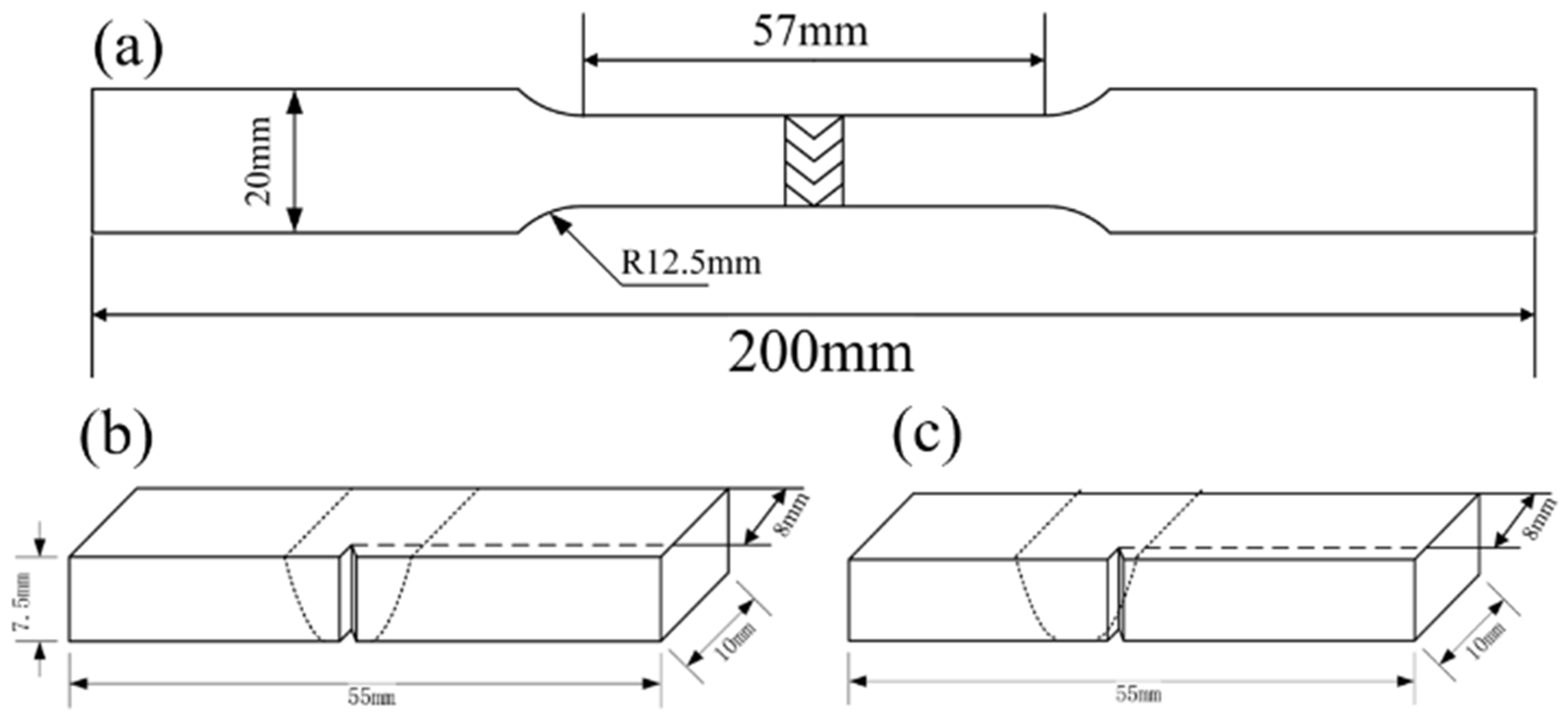


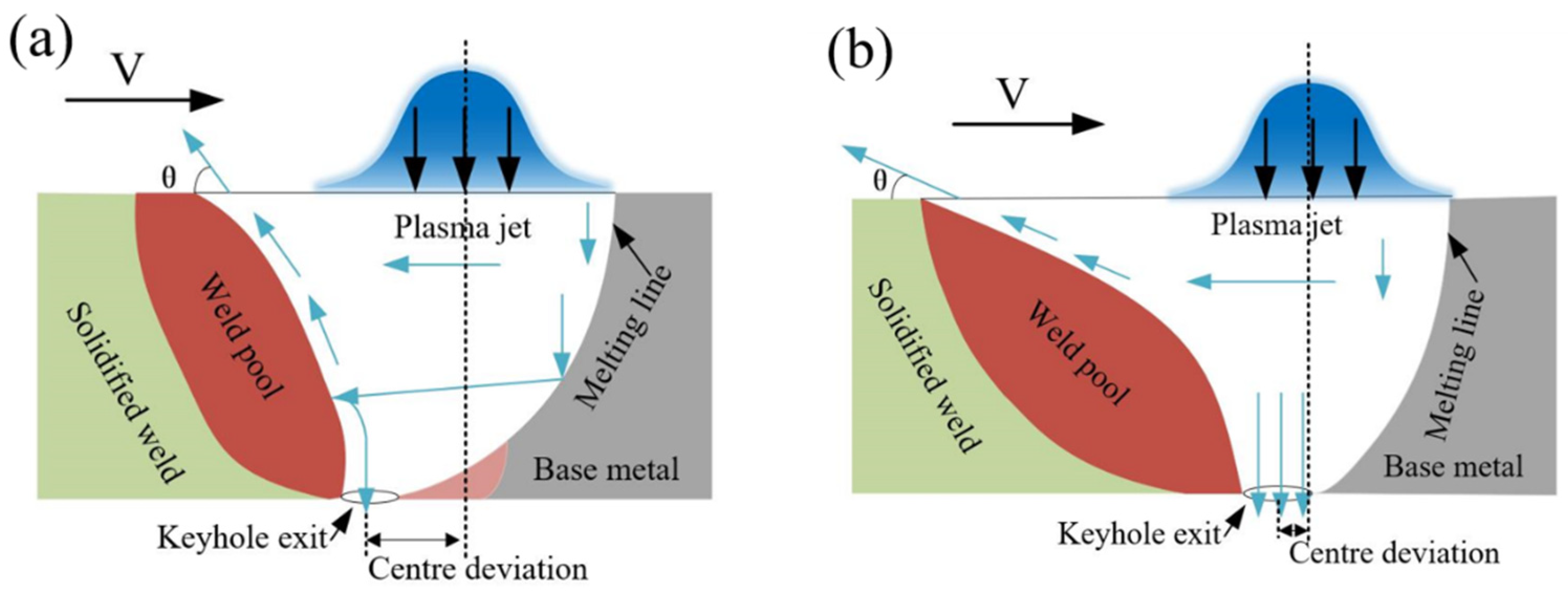
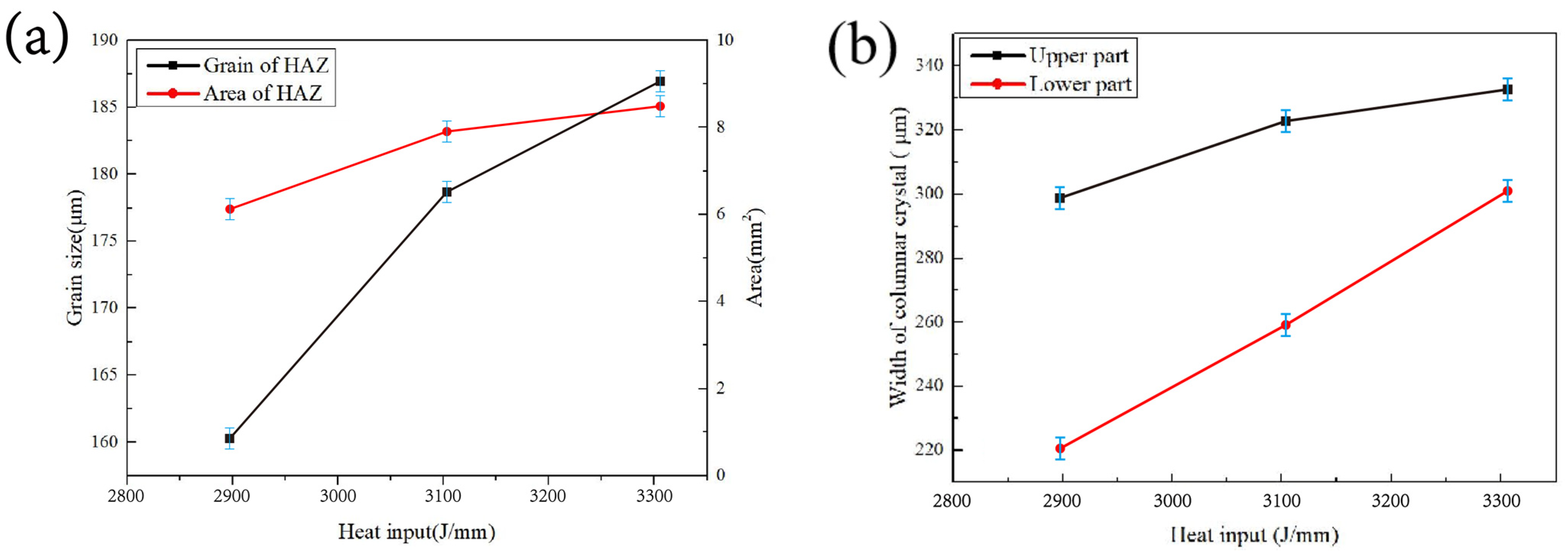

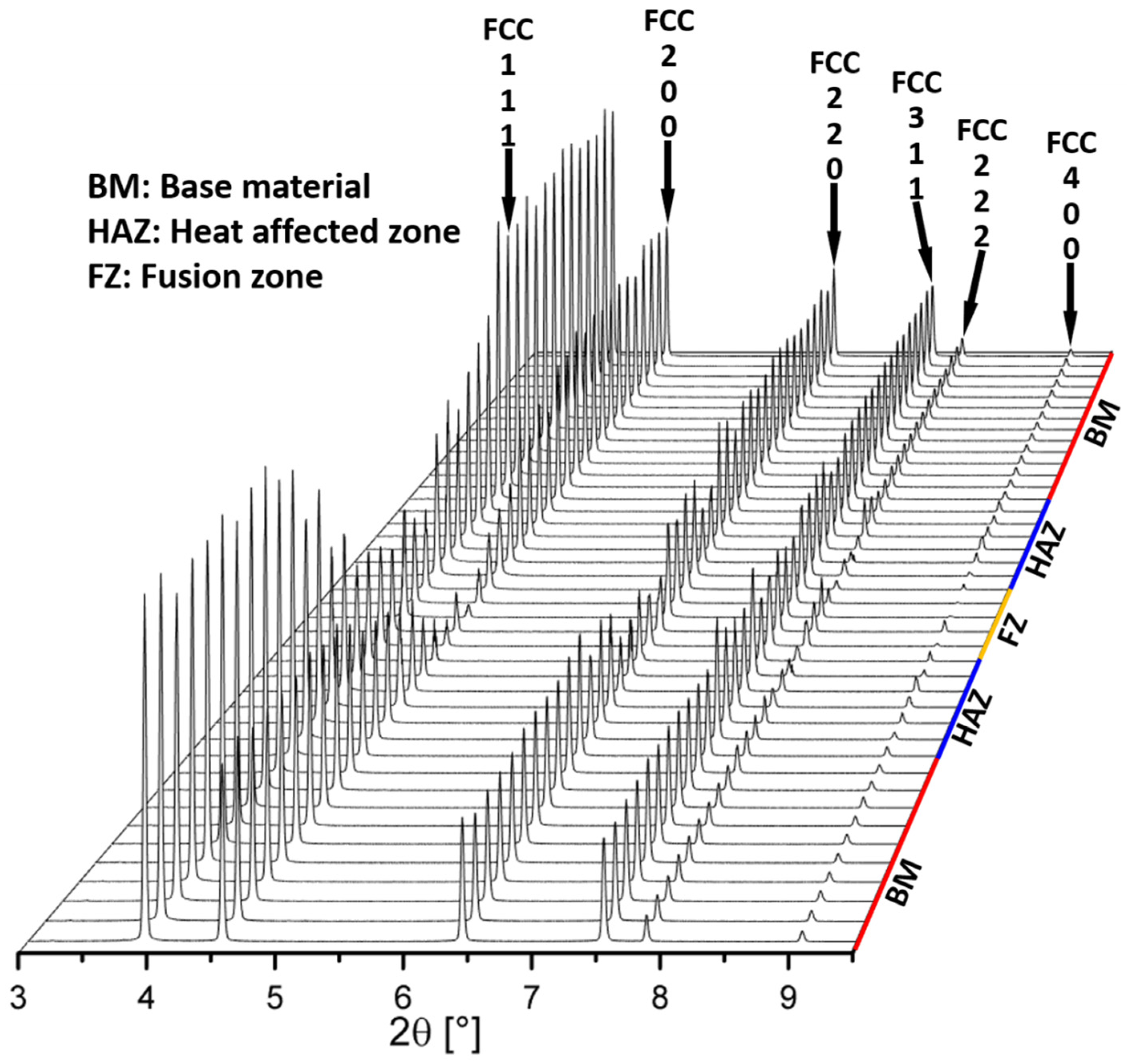
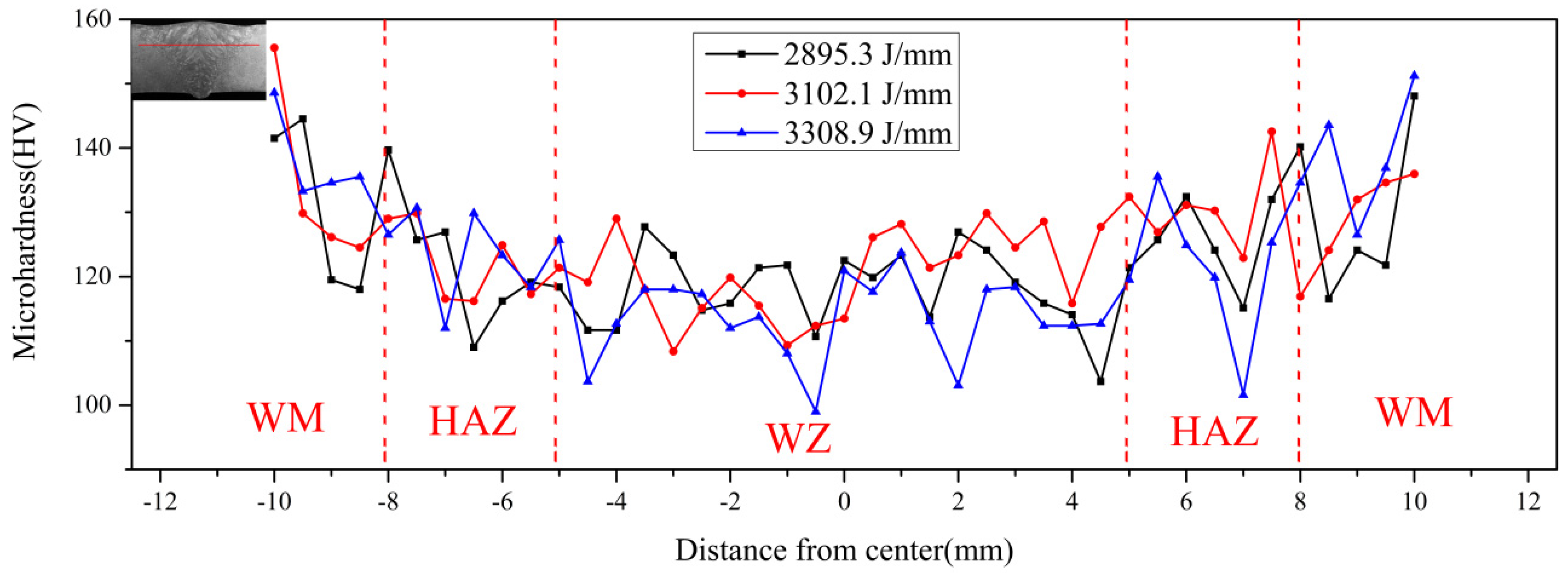
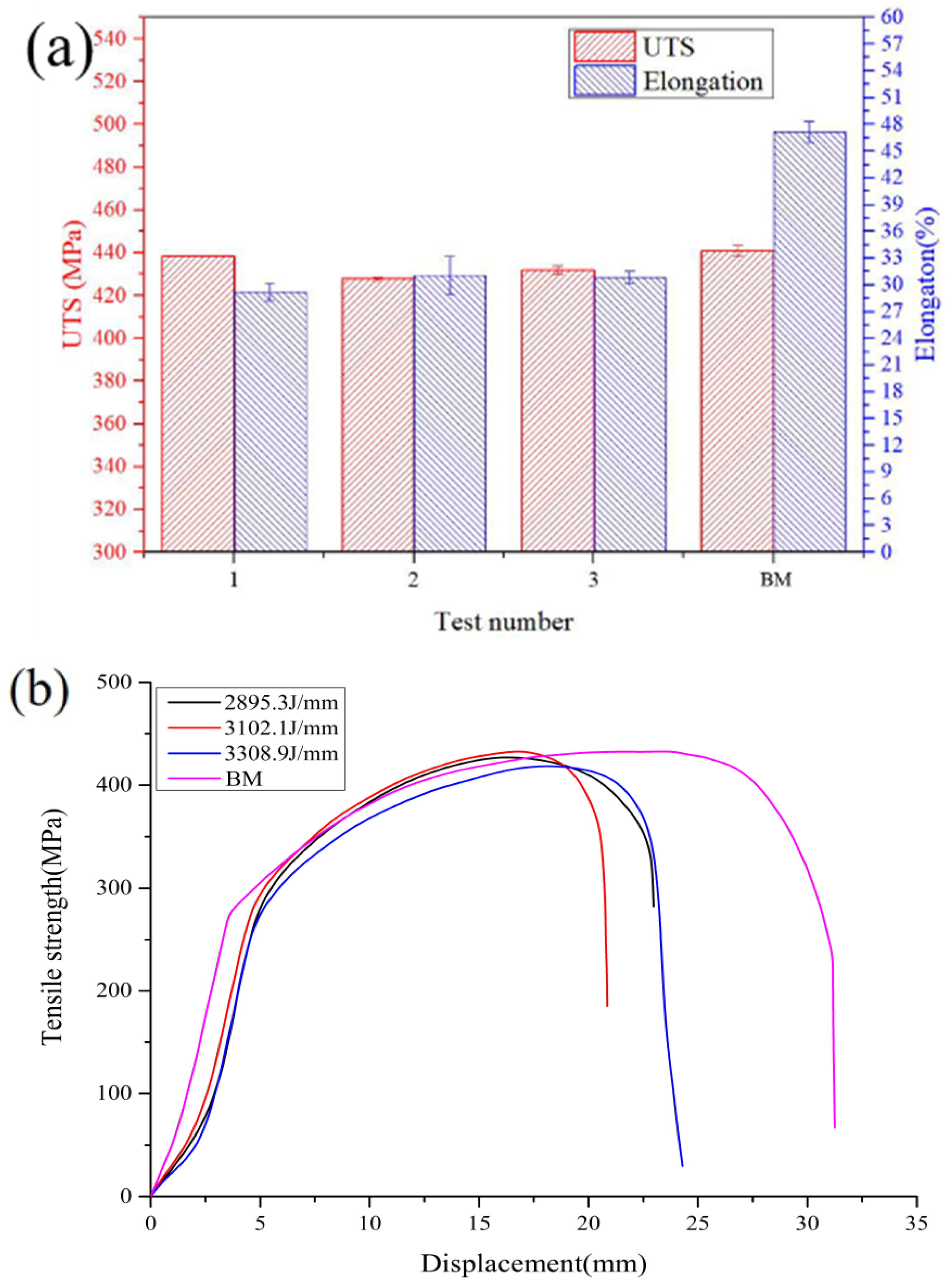
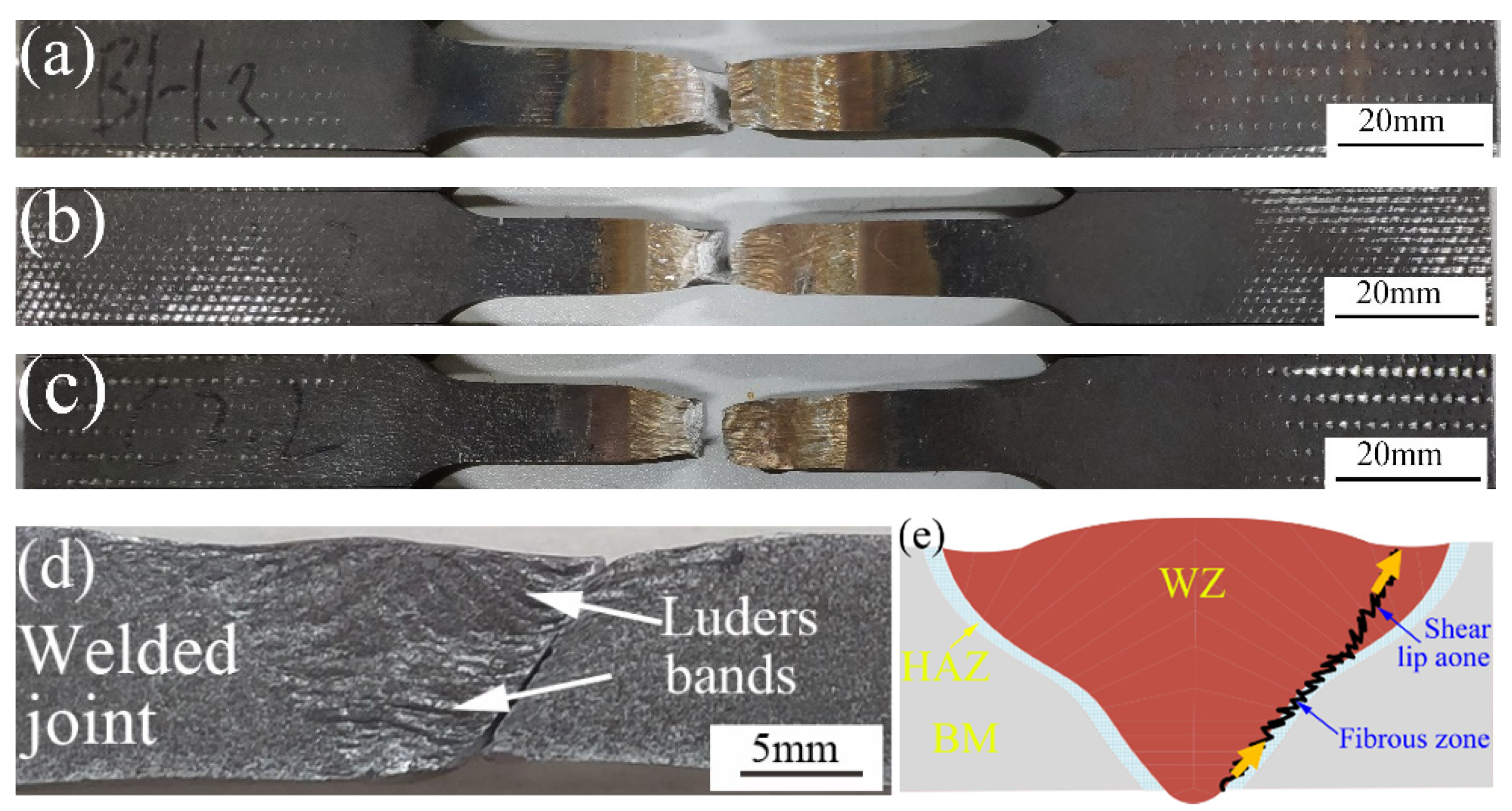
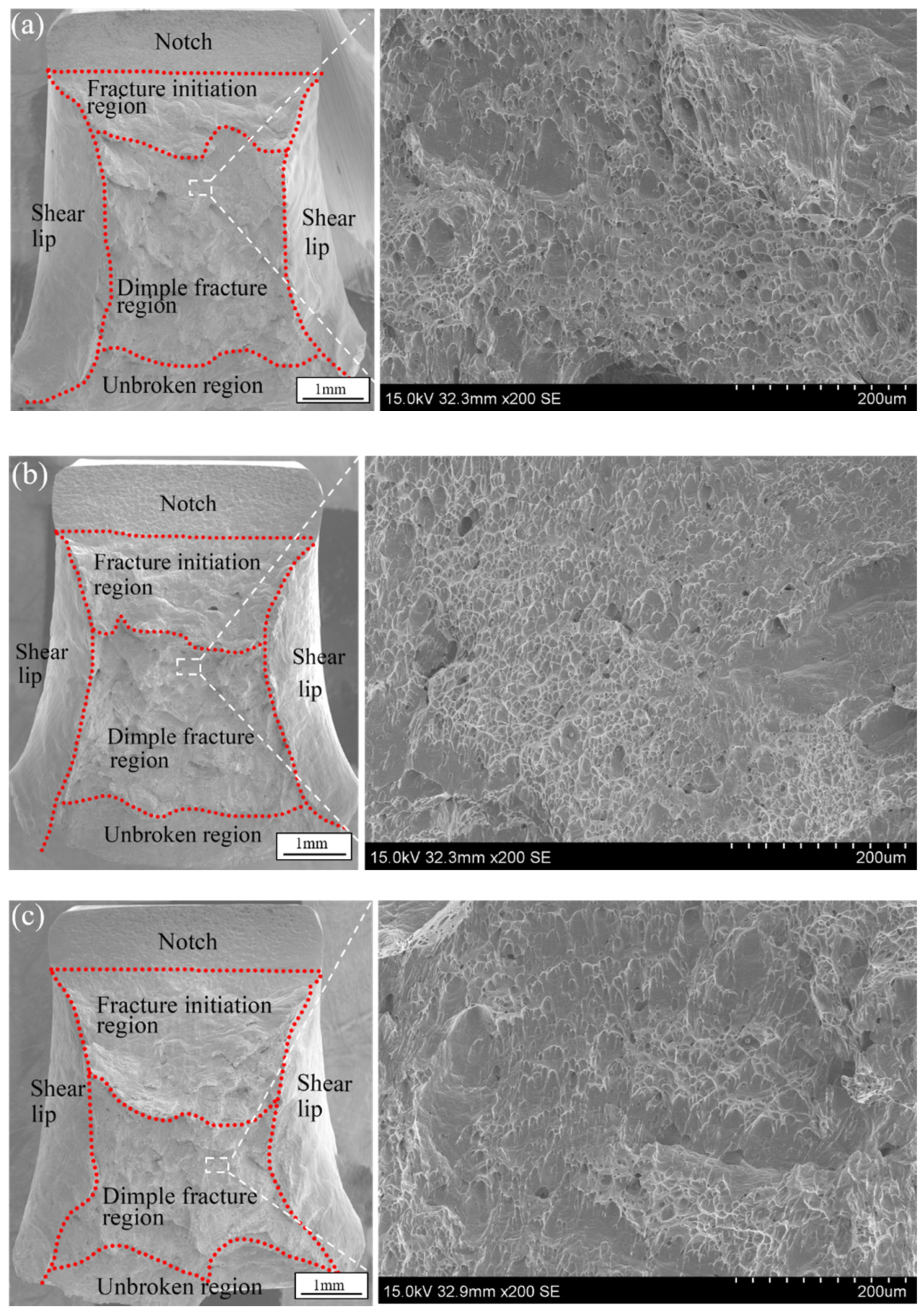
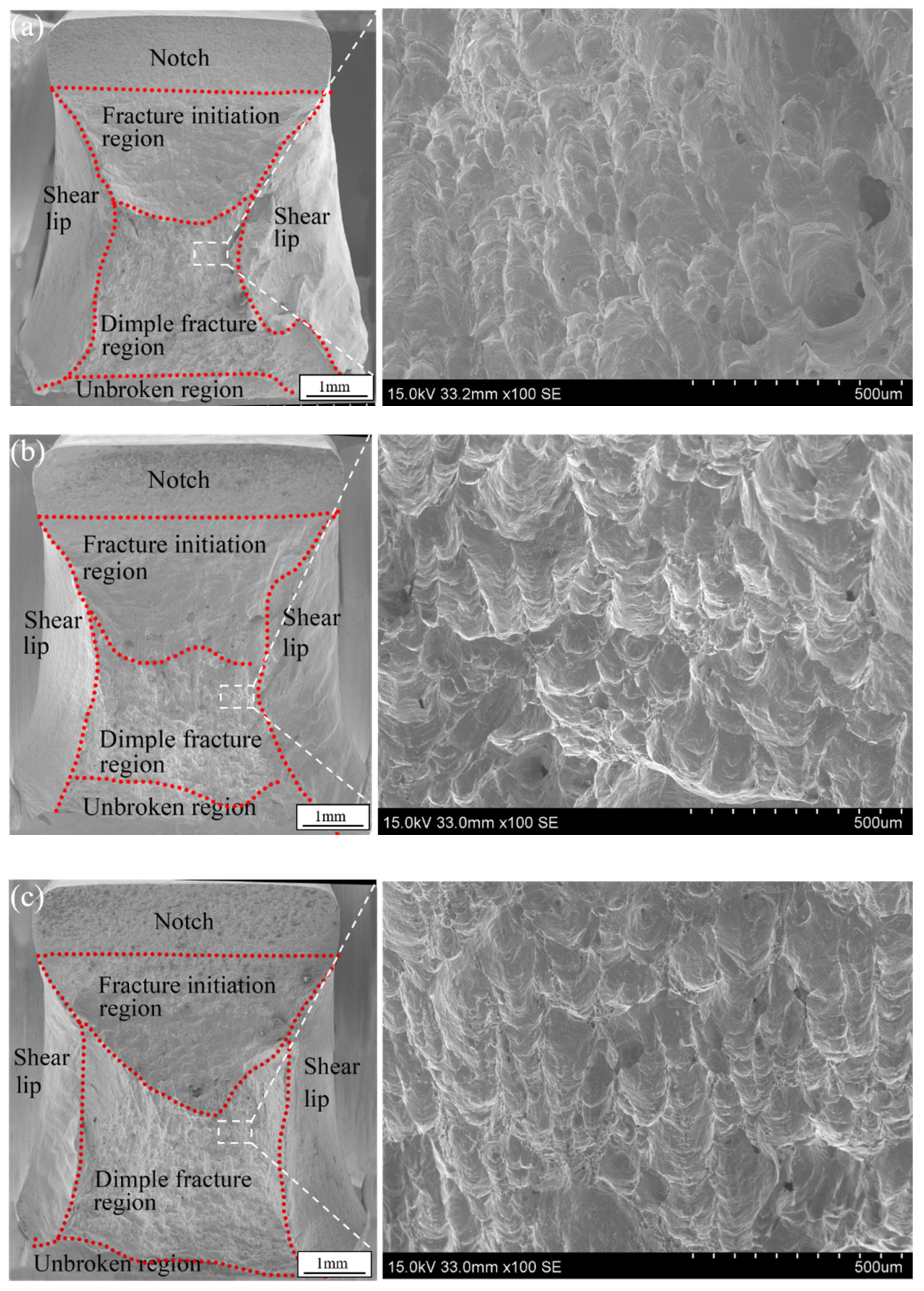

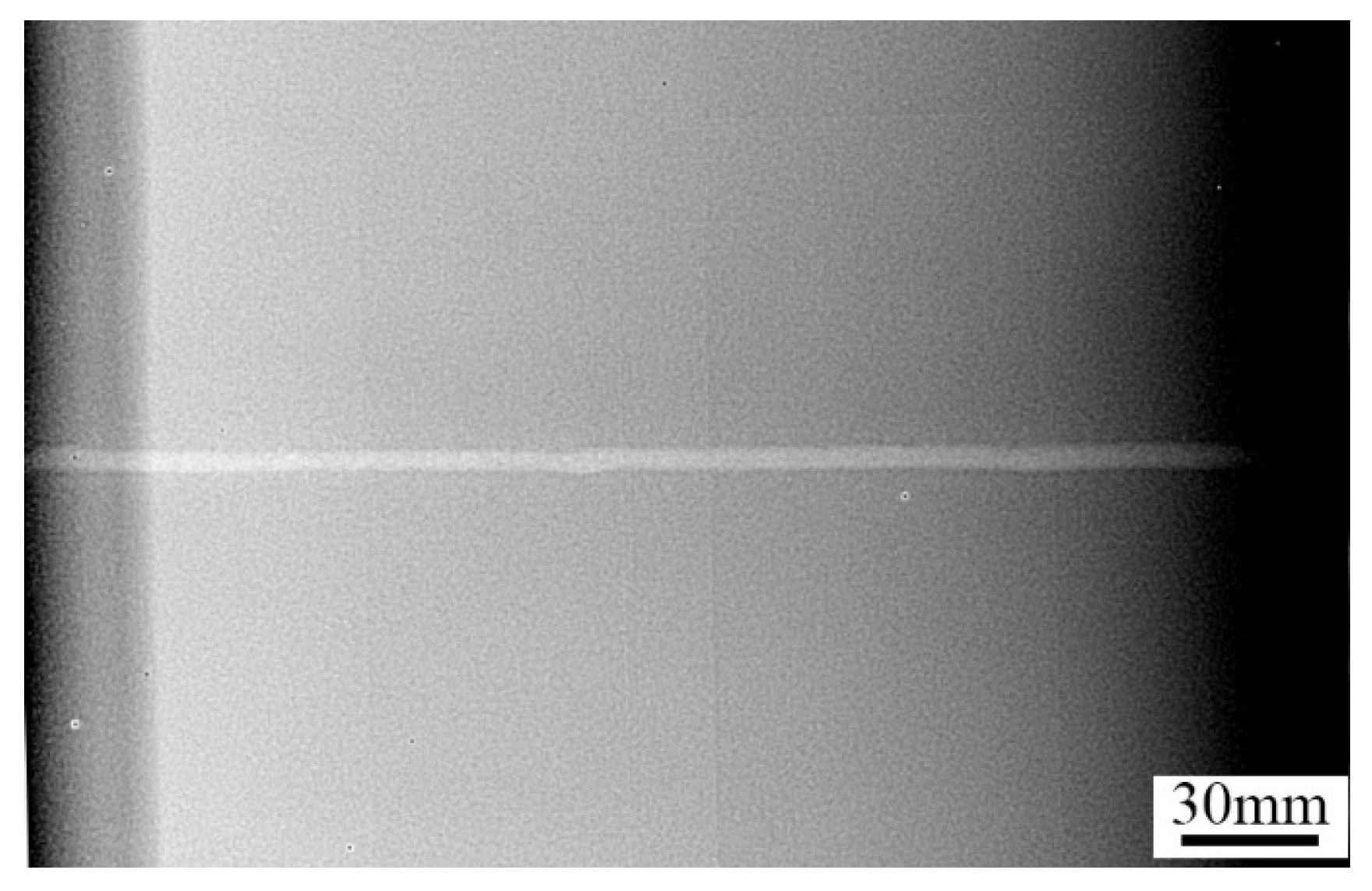
| C | Si | Mn | P | S | Ni | Fe |
|---|---|---|---|---|---|---|
| 0.05 | 0.2 | 0.2–0.6 | 0.02 | 0.02 | 35–37 | Balance |
| Sample Number | Welding Current (A) | Welding Speed (mm/min) | Welding Voltage (V) | Heat Input (J/mm) | Joint Gap | Shielding Gas Flow Rate |
|---|---|---|---|---|---|---|
| 1 | 420 | 2.35 | 18 | 2895.3 | 0 | 24 L/min |
| 2 | 450 | 2.35 | 18 | 3102.1 | 0 | 24 L/min |
| 3 | 480 | 2.35 | 18 | 3308.9 | 0 | 24 L/min |
| Sample Number | Heat Input (J/mm) | Impact Property, Ak (J) | |
|---|---|---|---|
| FZ | HAZ | ||
| 1 | 2895.3 |  | |
| 179.7 | 172.8 | ||
| 2 | 3102.1 |  | |
| 161.8 | 157.2 | ||
| 3 | 3308.9 |  | |
| 151.8 | 150.5 | ||
| BM | --- |  | |
| 202.7 | |||
| Welding Process | Thickness of BM (mm) | Weld Speed (mm/min) | Elongation (%) | Microhardness (HV) | UTS of BM (Ta) (MPa) | UTS of Weld (Tb) (MPa) | Tb/Ta (%) |
|---|---|---|---|---|---|---|---|
| K-TIG (present work) | 10 | 235 | 29.2 | 115 | 441.0 | 438.0 | 99.3 |
| FSW [30] | 3 | 120 | 22 | 144 | 516.0 | 472.0 | 91.5 |
| Laser welding [31] | 3 | 1200 | 12 | 130 | 517.6 | 440.0 | 85.1 |
| Multi-layer multi-pass MIG welding [32] | 19.05 | 27 | 38 | 138 | 432 | 363 | 84.0 |
Disclaimer/Publisher’s Note: The statements, opinions and data contained in all publications are solely those of the individual author(s) and contributor(s) and not of MDPI and/or the editor(s). MDPI and/or the editor(s) disclaim responsibility for any injury to people or property resulting from any ideas, methods, instructions or products referred to in the content. |
© 2023 by the authors. Licensee MDPI, Basel, Switzerland. This article is an open access article distributed under the terms and conditions of the Creative Commons Attribution (CC BY) license (https://creativecommons.org/licenses/by/4.0/).
Share and Cite
Liu, H.; Lv, S.; Xuan, Y.; Oliveira, J.P.; Schell, N.; Shen, J.; Deng, J.; Wang, Y.; Yang, J. Effects of Heat Input on Weld Microstructure and Properties in Keyhole TIG Welding of Invar 36 Alloy. Materials 2023, 16, 3692. https://doi.org/10.3390/ma16103692
Liu H, Lv S, Xuan Y, Oliveira JP, Schell N, Shen J, Deng J, Wang Y, Yang J. Effects of Heat Input on Weld Microstructure and Properties in Keyhole TIG Welding of Invar 36 Alloy. Materials. 2023; 16(10):3692. https://doi.org/10.3390/ma16103692
Chicago/Turabian StyleLiu, Hongbing, Shanhui Lv, Yang Xuan, João Pedro Oliveira, Norbert Schell, Jiajia Shen, Jingyu Deng, Yuhua Wang, and Jin Yang. 2023. "Effects of Heat Input on Weld Microstructure and Properties in Keyhole TIG Welding of Invar 36 Alloy" Materials 16, no. 10: 3692. https://doi.org/10.3390/ma16103692
APA StyleLiu, H., Lv, S., Xuan, Y., Oliveira, J. P., Schell, N., Shen, J., Deng, J., Wang, Y., & Yang, J. (2023). Effects of Heat Input on Weld Microstructure and Properties in Keyhole TIG Welding of Invar 36 Alloy. Materials, 16(10), 3692. https://doi.org/10.3390/ma16103692








